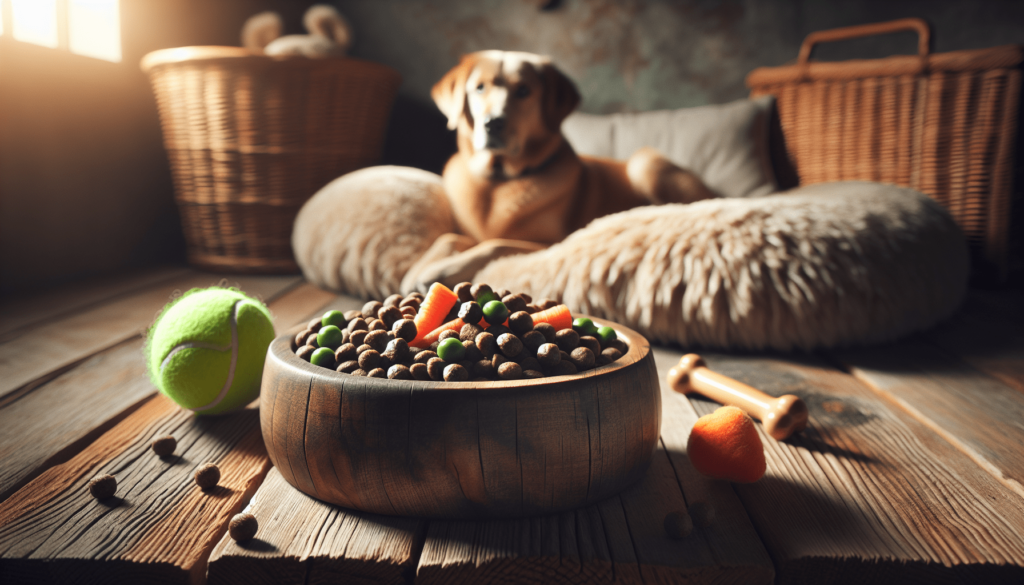What if you could enhance your senior dog’s mobility simply by tweaking their diet?
As aging pet parents, it’s vital to understand that nutrition plays a significant role in the health and mobility of our beloved companions.
Let’s navigate the world of senior dog diets together, ensuring that our furry friends can move freely and enjoy their golden years.

Understanding the Needs of Senior Dogs
As dogs age, their bodies undergo several changes that can affect their nutritional requirements.
You might be wondering, “How do I identify these needs?”
What Nutritional Changes Should I Look For?
Senior dogs often require fewer calories due to a decrease in activity levels. However, the need for high-quality protein remains crucial to maintain their muscle mass.
Additionally, they may benefit from an increase in certain nutrients:
- Antioxidants: Help combat oxidative stress.
- Omega fatty acids: Support joint health and reduce inflammation.
- Fiber: Aids digestion and can help manage weight.
How Can I Assess My Dog’s Current Diet?
Start by reviewing the label on their current dog food. Look for a balanced diet that includes protein sources, healthy fats, and vital vitamins and minerals.
It might be helpful to consult your veterinarian for personalized advice based on their specific health conditions.
What Are Common Health Issues in Senior Dogs?
As your dog ages, you might notice issues like arthritis, obesity, or dental problems. Each of these conditions can be significantly affected by diet.
For instance, obesity can complicate mobility, while arthritis can be exacerbated by inflammation.
Essential Ingredients for a Senior Dog Diet
Selecting the right ingredients can significantly impact your dog’s ability to remain active. So, what should you include in their meals?
Which Proteins Are Best for Senior Dogs?
Opt for lean proteins such as chicken, turkey, and fish. These options not only provide the necessary protein but also support muscle maintenance.
Be cautious of processed meats that may contain additives harmful to your dog.
What Carbohydrates Should I Include?
Carbohydrates provide energy, but the type matters. Whole grains like brown rice, oats, and quinoa are excellent choices as they offer fiber and nutrients.
Avoid fillers like corn or wheat, which have little nutritional value.
How Important Are Fats in a Senior Dog’s Diet?
Healthy fats can play a crucial role in your dog’s diet. Omega-3 and Omega-6 fatty acids are essential for supporting skin health and reducing inflammation.
Incorporate fish oil or flaxseed oil into their meals for added benefits.
Should I Consider Supplements?
In some cases, supplements can provide extra support for senior dogs. Glucosamine and chondroitin are popular choices for joint health.
Always consult your veterinarian before adding any supplements to your dog’s diet.
Portion Control and Feeding Strategies
Eating habits may need to change as your dog ages. Are you wondering how to adjust their feeding routine?
How Can I Determine the Right Amount to Feed?
First, assess your dog’s weight and activity level. Generally, senior dogs may need about 20–30% fewer calories than younger dogs.
Your vet can help you calculate the appropriate caloric intake based on your dog’s specific needs.
Should I Divide Their Meals?
Frequent, smaller meals can help with digestion and prevent obesity.
Instead of one or two large meals a day, consider feeding them three to four smaller portions to maintain steady energy levels.
What Times Should I Feed My Senior Dog?
Routine is key. Try to establish specific feeding times that suit your lifestyle and your dog’s needs. Consistency can aid in digestion and help them feel secure.
How Can I Encourage My Senior Dog to Eat?
Sometimes, older dogs may be picky eaters. Heating their food slightly, mixing in some wet food, or offering a variety can entice them to eat.
Ensuring they’re comfortable and stress-free during mealtimes can also make a significant difference.
Understanding Mobility and Nutrition Connection
What connection exists between your dog’s diet and their mobility? Let’s unravel this important relationship together.
How Does Nutrition Impact Joint Health?
A balanced diet rich in omega fatty acids and antioxidants can mitigate inflammation, providing much-needed relief for stiff or aching joints.
This is especially crucial for dogs suffering from arthritis.
Can Diet Affect Weight Management?
Yes! Keeping your dog at a healthy weight is vital for maintaining mobility. An overweight dog experiences more strain on joints, leading to reduced mobility.
Regular exercise combined with a proper diet will contribute to better weight management.
What Role Do Antioxidants Play?
Antioxidants help reduce oxidative stress within your dog’s body, which can help slow down the aging process.
Foods rich in antioxidants include blueberries, carrots, and spinach. Adding these to their diet can enhance overall health and support mobility.
How Can I Monitor My Dog’s Mobility?
Keeping track of your dog’s movement can alert you to potential problems.
Watch for signs like reluctance to jump or play, stiffness after lying down, or changes in walking patterns. Early intervention can lead to better outcomes.

Real-World Examples
What does a senior dog diet look like in practice? Let’s take a look at some hypothetical scenarios.
Meet Bailey: The Labrador with Joint Discomfort
Bailey’s owner noticed that her energetic Labrador started limping after playtime.
By switching to a diet that included joint health supplements and increasing omega fatty acids, they saw an improvement in Bailey’s condition.
Less stiffness after exercise allowed her to enjoy her walks again.
Meet Bella: The Picky Eater
Bella, a senior Dachshund, started to eat less due to dental issues. Her owner adjusted her diet, incorporating softer foods and adding enticing toppings.
With this change, Bella regained her appetite and energy levels, making her more playful.
Meet Max: The Overweight Golden Retriever
Max’s owner was concerned about his weight and sluggishness. By reducing his caloric intake, implementing portion control, and introducing a high-fiber diet, Max lost weight.
This made a noticeable difference in his mobility, allowing him to go on longer walks without fatigue.
Meet Roscoe: The Cocker Spaniel with a Sensitive Stomach
Roscoe’s digestive issues were impacting his mobility. His owner consulted the vet and transitioned him to a specialized senior dog food that was easy to digest.
Once his tummy settled, Roscoe exhibited increased energy and vitality, which made playtime much more enjoyable.
Tips for Making Dietary Changes
Transitioning your dog to a new diet might feel daunting, but it’s easier than you think. What steps can you follow to make this change smoother?
How Should I Introduce New Foods?
Start slow. Gradually mix a small amount of the new food with their current diet over several days. This allows your dog’s digestive system to adjust without causing discomfort.
What Signs Should I Watch For During a Transition?
Monitor your dog for signs of gastrointestinal distress, such as vomiting, diarrhea, or loss of appetite. If such symptoms occur, slow down the transition process or consult your vet for advice.
How Can I Stay Consistent?
Consistency is key not just with meal times but also with the ingredients in your dog’s diet.
Choose a reputable brand of senior dog food that meets your dog’s nutritional needs and stick with it to avoid any further disruptions.
What If My Dog Has Specific Health Concerns?
Always discuss any specific health concerns with your veterinarian.
They can provide tailored recommendations and ensure that dietary changes support your dog’s health conditions effectively.
Frequently Asked Questions
- How often should I feed my senior dog?
- Typically, three to four smaller meals a day are best for digestion.
- Can I give my dog human food?
- Some human foods are safe, like carrots and apples, but always check with your vet for potential hazards.
- What should I look for in senior dog food?
- Focus on high-quality protein, omega fatty acids, fiber, and essential vitamins and minerals.
- How can I tell if my dog is overweight?
- Observe their waistline and check if you can feel their ribs without excess fat covering.
- Are supplements necessary for my senior dog?
- It depends on individual health conditions. Speak to your vet about whether supplements like glucosamine might help.
- How can I help my senior dog stay active?
- Regular short walks and gentle play can keep them moving without overstressing their joints.
- What are some natural joint supplements I can consider?
- Look for glucosamine and chondroitin or discuss with your vet about herbal options.
- How can I improve my dog’s dental health through diet?
- Choose dental chews and kibble designed to promote oral health.
- What foods should I avoid for my senior dog?
- Avoid foods with fillers, those high in fat, and any toxic foods like chocolate or onions.
- How do I recognize early signs of arthritis?
- Look for stiffness, reluctance to exercise, and difficulty climbing stairs or jumping.
Conclusion
By making thoughtful dietary choices for your senior dog, you have the power to enhance their mobility and overall enjoyment of life.
Every small change can lead to significant improvements, ensuring your furry friend remains playful and vibrant.
As you move forward, consider consulting your veterinarian for tailored advice and implement these dietary tips to see the difference.
Your commitment to your dog’s nutrition is not just about feeding them but about nurturing a long, loving connection.
If you’re ready to make a change, start by gradually incorporating new foods into your dog’s diet.
Each positive step you take will contribute to a happier, healthier, and more mobile life for your beloved senior dog.
Remember, their golden years should be comfy and full of joy, and it begins with what’s in their bowl.
